2016 HONDA ODYSSEY weight
[x] Cancel search: weightPage 61 of 565
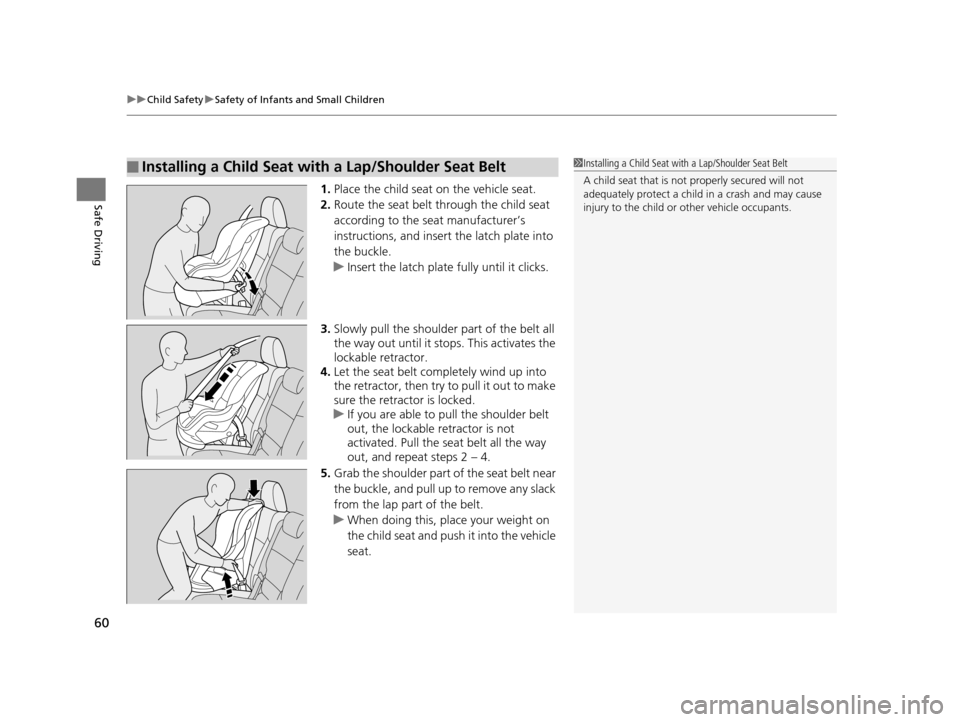
uuChild Safety uSafety of Infants and Small Children
60
Safe Driving1. Place the child seat on the vehicle seat.
2. Route the seat belt through the child seat
according to the seat manufacturer’s
instructions, and insert the latch plate into
the buckle.
u Insert the latch plate fully until it clicks.
3. Slowly pull the shoulder part of the belt all
the way out until it stops. This activates the
lockable retractor.
4. Let the seat belt completely wind up into
the retractor, then try to pull it out to make
sure the retractor is locked.
u If you are able to pull the shoulder belt
out, the lockable retractor is not
activated. Pull the seat belt all the way
out, and repeat steps 2 – 4.
5. Grab the shoulder part of the seat belt near
the buckle, and pull up to remove any slack
from the lap part of the belt.
u When doing this, plac e your weight on
the child seat and push it into the vehicle
seat.
■Installing a Child Seat with a Lap/Shoulder Seat Belt1 Installing a Child Seat with a Lap/Shoulder Seat Belt
A child seat that is not properly secured will not
adequately protect a child in a crash and may cause
injury to the child or other vehicle occupants.
16 US ODYSSEY-31TK86500.book 60 ページ 2015年6月24日 水曜日 午後3時0分
Page 66 of 565
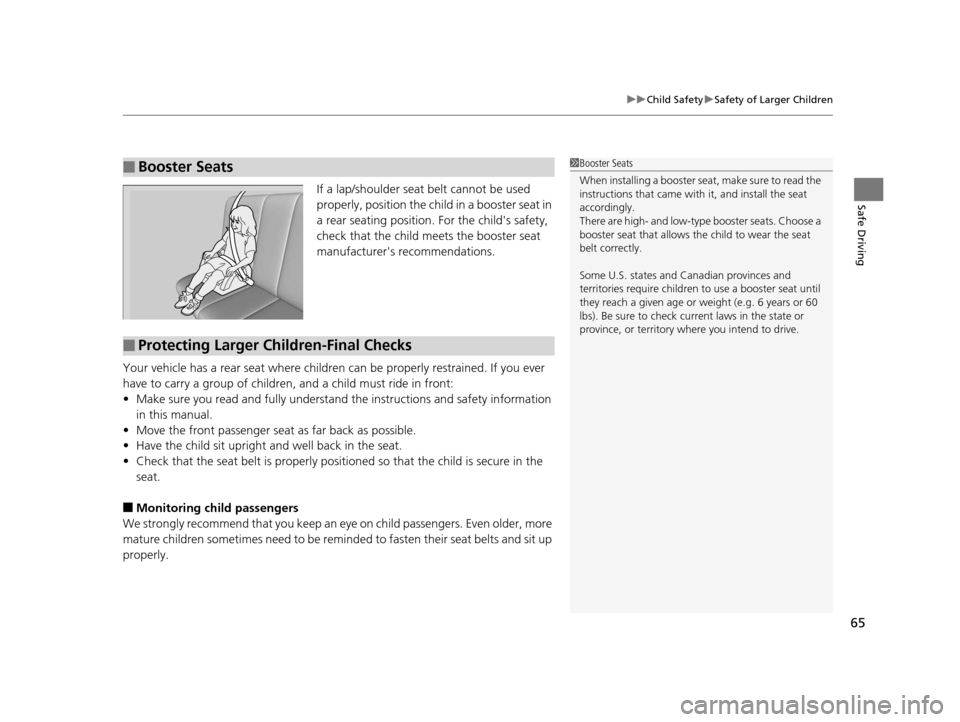
65
uuChild Safety uSafety of Larger Children
Safe DrivingIf a lap/shoulder seat belt cannot be used
properly, position the child in a booster seat in
a rear seating position. For the child's safety,
check that the child meets the booster seat
manufacturer's recommendations.
Your vehicle has a rear seat where children can be properly restrained. If you ever
have to carry a group of children, and a child must ride in front:
• Make sure you read and fully understand the instructions and safety information
in this manual.
• Move the front passenger seat as far back as possible.
• Have the child sit upright and well back in the seat.
• Check that the seat belt is properly positi oned so that the child is secure in the
seat.
■Monitoring child passengers
We strongly recommend that you keep an ey e on child passengers. Even older, more
mature children sometimes need to be remi nded to fasten their seat belts and sit up
properly.
■Booster Seats1 Booster Seats
When installing a booster seat, make sure to read the
instructions that came with it, and install the seat
accordingly.
There are high- and low-type booster seats. Choose a
booster seat that allows the child to wear the seat
belt correctly.
Some U.S. states and Canadian provinces and
territories require children to use a booster seat until
they reach a given age or weight (e.g. 6 years or 60
lbs). Be sure to check current laws in the state or
province, or territory where you intend to drive.
■Protecting Larger Children-Final Checks
16 US ODYSSEY-31TK86500.book 65 ページ 2015年6月24日 水曜日 午後3時0分
Page 122 of 565

121
Controls
Opening and Closing the Tailgate
Precautions for Opening/Closing the Tailgate
Always make sure individuals and objects are clear of the tailgate before opening or
closing it.
■Opening the tailgate
• Open the tailgate all the way.
u If it is not fully opened, the tailgate may begin to close under its own weight.
• Be careful when it is windy. The wi nd may cause the tailgate to close.
■Closing the tailgate
Keep the tailgate closed while driving to: u Avoid possible damage.
u Prevent exhaust gas from leaking into the vehicle.
2 Exhaust Gas Hazard P. 66
1Precautions for Opening/Closing the Tailgate
Be careful not to hit your head on the tailgate or to
put your hands between th e tailgate and the cargo
area.
When operating the power tailgate, make sure there
is enough space around your ve hicle. People near the
tailgate may be se riously hurt if the tailgate hits their
head or closes on their head s. Be especially cautious
if children are around.
When you are storing or pi cking up luggage from the
cargo area while the engine is idling, do not stand in
front of the exhaust pipe. You may get burned.
Do not allow any passenger in the cargo space. They
may get hurt during hard braking, a sudden
acceleration, or a crash.
3WARNING
Closing a power tailgate while anyone is in
the path of the tailgate can cause serious
injury.
Make sure everyone is clear before closing
the tailgate.
Models with power tailgate
16 US ODYSSEY-31TK86500.book 121 ページ 2015年6月24日 水曜日 午後3時0分
Page 127 of 565
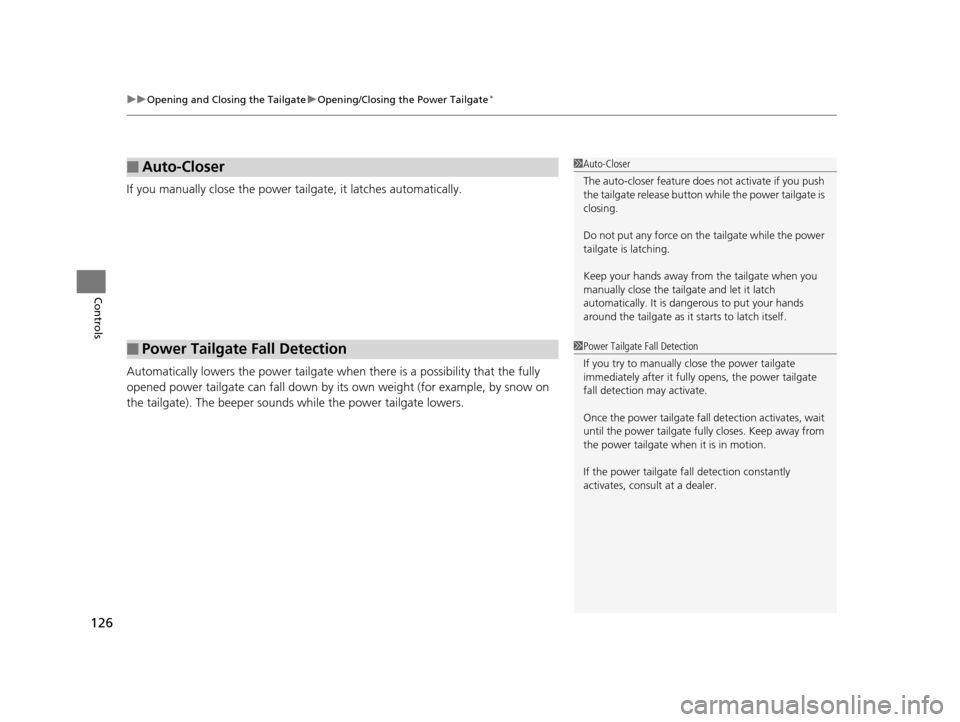
uuOpening and Closing the Tailgate uOpening/Closing the Power Tailgate*
126
Controls
If you manually close the power ta ilgate, it latches automatically.
Automatically lowers the power tailgate wh en there is a possibility that the fully
opened power tailgate can fall down by it s own weight (for example, by snow on
the tailgate). The beeper sounds while the power tailgate lowers.
■Auto-Closer
■Power Tailgate Fall Detection
1 Auto-Closer
The auto-closer feature does not activate if you push
the tailgate release button while the power tailgate is
closing.
Do not put any force on the tailgate while the power
tailgate is latching.
Keep your hands away from the tailgate when you
manually close the tailga te and let it latch
automatically. It is dange rous to put your hands
around the tailgate as it st arts to latch itself.
1Power Tailgate Fall Detection
If you try to manually close the power tailgate
immediately after it full y opens, the power tailgate
fall detection may activate.
Once the power tailgate fall detection activates, wait
until the power tailgate full y closes. Keep away from
the power tailgate when it is in motion.
If the power tailgate fa ll detection constantly
activates, consult at a dealer.
16 US ODYSSEY-31TK86500.book 126 ページ 2015年6月24日 水曜日 午後3時0分
Page 128 of 565

127
Controls
Opening and Closing the Sliding Doors
Precautions for Opening/Closing the Sliding Doors
Always make sure individuals and objects are clear of the sliding doors.
■Opening the sliding doors
Open the door all the way until it stops. u If it is not fully opened, the door may close again by its own weight.
1Precautions for Opening/Closing the Sliding Doors
Do not leave the sliding door open while parking on
a slope. The door may slide close by its weight.
When opening or closing th e sliding doors, do not
grab the door or place your hand on the vehicle body.
Use the handle.
Do not put your foot and hand on the sliding door rail
and on the rollers.
If a small child is in the vehicle, use the childproof
door locks to prevent the chil d in the rear seat from
accidentally opening the sliding doors.
2 Childproof Door Locks P. 119
Do not put any items that stick out from the pocket
in the door pockets. It may prevent the doors from
properly opening or closing, and damage the vehicle.
3WARNING
Closing a sliding door while any part of a
passenger is in the door’s path can cause
serious injury.
Make sure all passengers are clear of the
doorway before closing a sliding door.
16 US ODYSSEY-31TK86500.book 127 ページ 2015年6月24日 水曜日 午後3時0分
Page 131 of 565

uuOpening and Closing the Sliding Doors uOpening/Closing the Power Sliding Doors*
130
Controls
■Switching between manual and automatic operations
Automatic operation: Select the ON
position of the sliding door main switch.
Manual operation: Select the OFF position
of the sliding door main switch.
2 Opening/Closing a Sliding Door P. 128
1Opening/Closing the Power Sliding Doors*
Do not turn the main switch off while the power
sliding door is in opera tion on a slope. The power
sliding door’s fail-safe mode activates and the beeper
sounds continuously.
When the fail-safe mode is active, turn the main
switch on and close the door automatically.
The following can deactivate the fail-safe mode and
the sliding door may close by its own weight.
•Using the door handle
•Turning the main switch from ON to OFF
If you replace the battery or the power sliding door
fuse while the door is ope n, the power sliding door
may be disabled. The power sliding door resumes
once you manually close the door.
OFF ON
* Not available on all models
16 US ODYSSEY-31TK86500.book 130 ページ 2015年6月24日 水曜日 午後3時0分
Page 400 of 565
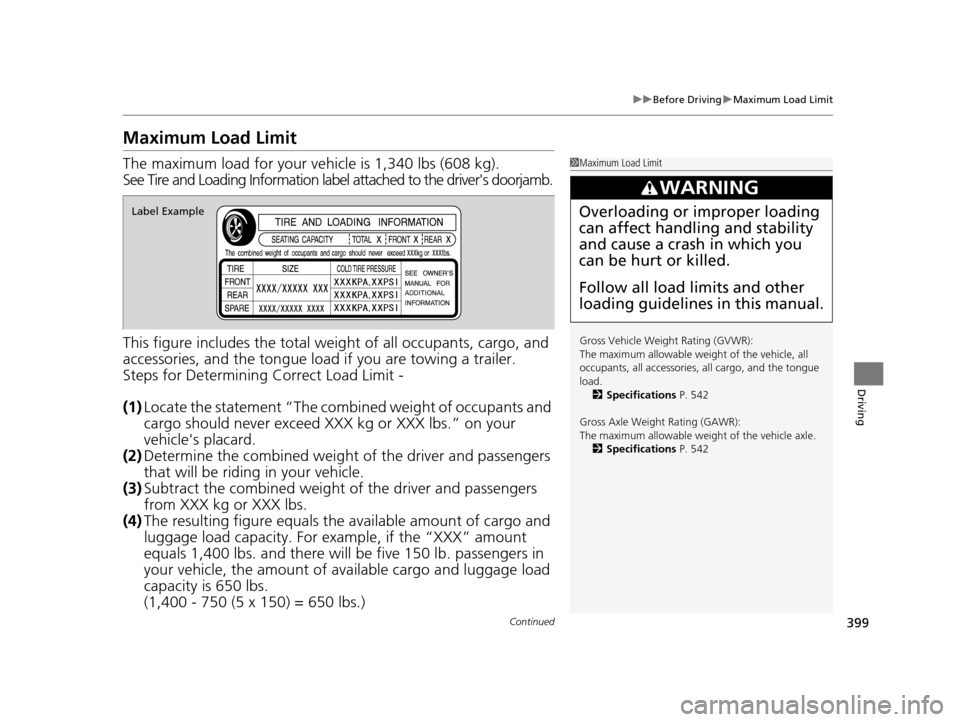
399
uuBefore Driving uMaximum Load Limit
Continued
Driving
Maximum Load Limit
The maximum load for your ve hicle is 1,340 lbs (608 kg).
See Tire and Loading Information label attached to the driver's doorjamb.
This figure includes the total weig ht of all occupants, cargo, and
accessories, and the tongue load if you are towing a trailer.
Steps for Determining Correct Load Limit -
(1) Locate the statement “The comb ined weight of occupants and
cargo should never exceed XXX kg or XXX lbs.” on your
vehicle's placard.
(2) Determine the combined weight of the driver and passengers
that will be riding in your vehicle.
(3) Subtract the combined weight of the driver and passengers
from XXX kg or XXX lbs.
(4) The resulting figure equals the available amount of cargo and
luggage load capacity. For example, if the “XXX” amount
equals 1,400 lbs. and there will be five 150 lb. passengers in
your vehicle, the am ount of available cargo and luggage load
capacity is 650 lbs.
(1,400 - 750 (5 x 150) = 650 lbs.)1 Maximum Load Limit
Gross Vehicle Weight Rating (GVWR):
The maximum allowable weight of the vehicle, all
occupants, all a ccessories, all cargo, and the tongue
load. 2 Specifications P. 542
Gross Axle Weight Rating (GAWR):
The maximum allowable weight of the vehicle axle. 2 Specifications P. 542
3WARNING
Overloading or improper loading
can affect handling and stability
and cause a crash in which you
can be hurt or killed.
Follow all load limits and other
loading guidelines in this manual.Label Example
16 US ODYSSEY-31TK86500.book 399 ページ 2015年6月24日 水曜日 午後3時0分
Page 401 of 565
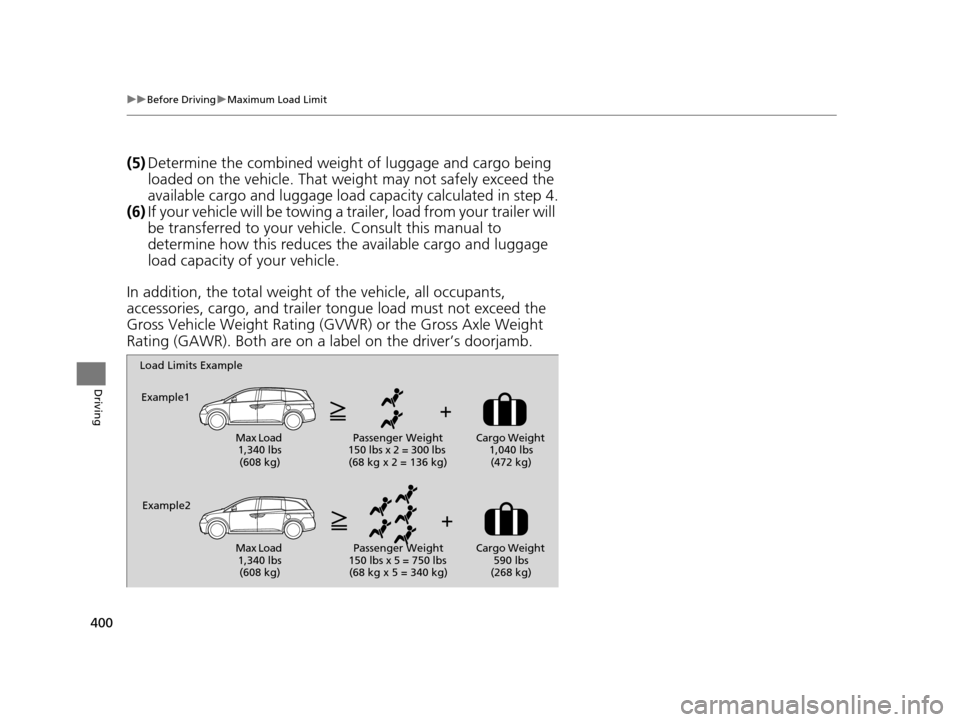
400
uuBefore Driving uMaximum Load Limit
Driving
(5) Determine the combined weight of luggage and cargo being
loaded on the vehicle. That we ight may not safely exceed the
available cargo and luggage load capacity calculated in step 4.
(6) If your vehicle will be towing a tra iler, load from your trailer will
be transferred to your vehicl e. Consult this manual to
determine how this reduces the available cargo and luggage
load capacity of your vehicle.
In addition, the total weight of the vehicle, all occupants,
accessories, cargo, and trailer tongue load must not exceed the
Gross Vehicle Weight Rating (GVW R) or the Gross Axle Weight
Rating (GAWR). Both are on a label on the driver’s doorjamb.
Load Limits Example
Example1
Max Load 1,340 lbs (608 kg) Passenger Weight
150 lbs x 2 = 300 lbs (68 kg x 2 = 136 kg) Cargo Weight
1,040 lbs (472 kg)
Example2 Max Load 1,340 lbs (608 kg) Passenger Weight
150 lbs x 5 = 750 lbs (68 kg x 5 = 340 kg) Cargo Weight
590 lbs
(268 kg)
16 US ODYSSEY-31TK86500.book 400 ページ 2015年6月24日 水曜日 午後3時0分